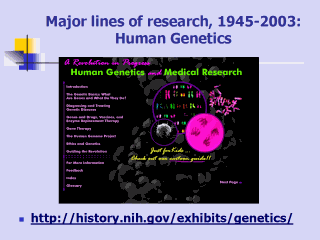| front |1 |2 |3 |4 |5 |6 |7 |8 |9 |10 |11 |12 |13 |14 |15 |16 |17 |18 |19 |20 |21 |22 |23 |24 |25 |26 |27 |28 |29 |30 |31 |32 |33 |34 |35 |36 |37 |38 |39 |review |
 |
Since 1945, the
portfolio of research projects funded or directly conducted by NIH has
expanded exponentially. It would be impossible to trace all the lines of
research, and so only a few will be highlighted here. First is research into
genetics. Following the discovery of the double helical structure of DNA in
1953, the NIH began supporting studies of how this genetic material might
work. In 1961, an intramural scientist, Dr. Marshall Nirenberg, published
the first "word" of the genetic code, and his subsequent work to decipher
the code won him the 1968 Nobel Prize in Medicine and Physiology.
In 1973, the ability to cut and recombine DNA led to concern over the safety of research in this area. NIH led the deliberations of the scientific community toward guidelines and the creation of a Recombinant DNA Advisory Committee—known as the "RAC"—which permitted research to continue under strict oversight. In 1988, the Human Genome Project was launched. In the United States, it was placed under the auspices of the NIH and the U.S. Department of Energy. Worldwide research on the genome produced a complete first draft by 2003. In 1990, the first gene therapy experiment was conducted in the NIH Clinical Center on a 4-year old girl with a disease caused by a mutation in a single gene. Gene therapy studies have a long way to go to realize their promise but continue in hope of curing the diseases caused by pathological genetic mutations. For an overview of research in genetics, the Office of NIH History has prepared a website called "A Revolution in Progress: Human Genetics and Medical Research." Its URL is http://history.nih.gov/exhibits/genetics |